Home-brew has a bit of a mixed reputation, it’s fair to say! This is my method for making great, simple, real cider (hard cider, for those of you West of the Atlantic!) with almost no investment in special equipment. Sounds too good to be true? Follow these instructions, and in just a few weeks time you can be drinking great cider (at least as good as most commercial bottled ciders you can buy!) that you’ve made yourself, and all for only a few pence more than the cost of cheap retail apple juice. I just wish I’d known how to do this when I was a student – it would have saved me a fortune and quite possibly made me rather popular, too!
Last autumn, I made real ‘Real Cider’ from fresh apples. I promised then I’d post quicker and simpler instructions for a short-cut brew. Well, rather belatedly, here they are!
First a brief note on the law – I have no idea if home brewing is legal in your country or jurisdiction, or what restrictions might apply. If you’re restricted (by age, local religious observance, or otherwise!) from buying, possessing or consuming alcohol, it’s very likely local law enforcement may take an interest in you brewing it yourself, so please take appropriate advice! In the UK, I believe home brewing is legal for personal consumption, however sale and distilling are tightly restricted.
The minimum set of ingredients and equipment you require are –
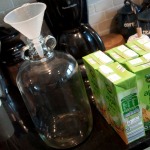 5 litres of ‘pure apple juice’ (the clear, cheap, from concentrate variety from your local discount supermarket is fine, but it should contain no additives or preservatives)
5 litres of ‘pure apple juice’ (the clear, cheap, from concentrate variety from your local discount supermarket is fine, but it should contain no additives or preservatives)- Half a mug of very strong tea (use two tea bags – plain ones unless you fancy an unusual experimental flavour sensation!)
- Wine yeast (this is widely available online or from your local friendly home-brew shop, and is cheapest in small pots rather than individual sachets – you could use bakers yeast as an emergency substitute, but it’s prone to producing strange flavours!)
- A glass demijohn, or an empty 5l mineral water bottle
- Home-brew steriliser (you could use Milton fluid as an alternative)
In another couple of weeks, you’ll also need to have gathered together –
- A length of syphon tubing (between 1m and 1.5m or 4ft to 6ft in length)
- Bottles, sufficient to contain your cider. These must be able to take pressure. Empty plastic screw-top fizzy drinks bottles are great for a first effort, and free. The plastic will be somewhat gas permeable, so the cider won’t keep terribly well in them, but I doubt you’ll be laying down your first brew long-term! Beer or champagne bottles are fine, but require special capping tools and equipment. Please note that SCREW TOP GLASS WINE BOTTLES ARE COMPLETELY UNSUITABLE and are very likely to result in dangerously explosive bottles.
- A few teaspoons each of sugar, and of a non-fermentable sweetener such as ‘Splenda’.
You might also like to add the following, which are not essential but will make the process simpler or more reliable –
- A drilled rubber bung (or grommet) & bubbler airlock, to fit your bottle or demijohn. If you don’t have these, you’ll need enough cotton wool to firmly plug the neck of your fermenter. [How to set up and use a bubbler airlock]
- Yeast nutrient (This contains all the trace elements and minerals required for healthy yeast growth. Apple juice is already pretty good for these, however, so it shouldn’t be necessary.)
- A kitchen funnel
- Bottle brush
- Hydrometer [How to use a hydrometer]
- Racking cane and tap or bottler attachment for your syphon tubing.
- Capping device and / or appropriate caps, gaskets, stoppers and closures, if you prefer to use recycled beer or champagne bottles.
If you’re lucky enough still to have a local home-brew shop, now is the time to go and make friends! You’ll get tons of helpful advice and guidance, and while the item costs are likely to be higher than from web retailers, you save on postage which can be a big consideration with small purchases. There are also lots of home-brew suppliers on the Internet, of course. I tend to use http://www.the-home-brew-shop.co.uk/ for most of my home-brew purchases, Amazon and eBay are also full of useful retailers for odd bits and bobs. Freecycle is the best source I can find for old-fashioned glass demijohns, and people are often giving away bottles, buckets, and other unwanted brewing items, it’s well worth posting a ‘wanted’ notice, these have served me very well for supplies in the past.
A quick totting up suggests you can get all you need for less than a tenner, and nearly everything except the apple juice is re-usable over and over (or at least, in the case of yeast and steriliser, for a good few batches!).
The process is really very straightforward, and divides neatly into four –
- Fermentation
- Bottling
- Secondary fermentation, and
- Drinking!
Stage 1 – Fermentation
First, wash out your demijohn very carefully, and sterilise it following the instructions on your steriliser solution. Second hand glass demijohns have often been abandonned in a slightly grubby state and will need a little TLC to get back into a usable state (a cranked bottle brush will be helpful if so). Pay close attention to the instructions that come with your steriliser solution, particularly where it comes to strength, contact time, and rinsing, since lack of attention to sterilisation and rinsing are responsible for most home-brew failures. While you’re at it, sterilise anything else you’re going to be using – including the bung, bubbler airlock, and a funnel if you think you’ll need it. Don’t neglect cleanliness, it’s critical to the success of any home-brewing enterprise. Sometimes I think home-brewing is really just washing up with benefits!
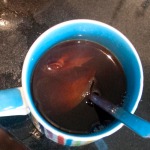 Pour four litres of the apple juice carefully into your demijohn. There will be some bubbly froth on top, this is fine (the juice will be nicely oxygenated). The demijohn will not be full – this is intentional! Add your half mug of very strong luke-warm tea, which provides some tannin for the cider, as apple juice intended for drinking will generally be quite poor in tannin.
Pour four litres of the apple juice carefully into your demijohn. There will be some bubbly froth on top, this is fine (the juice will be nicely oxygenated). The demijohn will not be full – this is intentional! Add your half mug of very strong luke-warm tea, which provides some tannin for the cider, as apple juice intended for drinking will generally be quite poor in tannin.
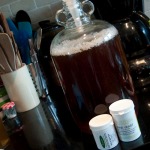
Add a teaspoon of yeast, and one of yeast nutrient if you have it to hand, and fit the bung and airlock or stopper the bottle with your cotton wool, tightly enough to stop bugs getting in.
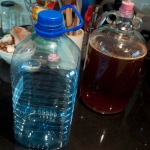 Now put your demijohn somewhere safe at room temperature (18 – 21 degrees is ideal, warmer temperatures such you’d have in an airing cupboard will certainly speed the process up, but are likely to be too warm and can produce ‘off’ flavours) and wait for the magic. If you’re lucky, this should start within as little as six hours or so, though this depends on how active your yeasty beasties are, and the prevailing temperature. While you could put it in a dark cupboard, I think you’ll want to keep it out somewhere where you can see it!
Now put your demijohn somewhere safe at room temperature (18 – 21 degrees is ideal, warmer temperatures such you’d have in an airing cupboard will certainly speed the process up, but are likely to be too warm and can produce ‘off’ flavours) and wait for the magic. If you’re lucky, this should start within as little as six hours or so, though this depends on how active your yeasty beasties are, and the prevailing temperature. While you could put it in a dark cupboard, I think you’ll want to keep it out somewhere where you can see it!
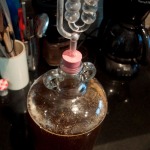 The first thing you’re likely to notice is the pellets of yeast starting to float around in the juice. Within 24 hours, there will probably be bubbles coming through the airlock. You can see the meniscus of the airlock water is pushed around in the photo on the left. If you’re anything like me, you’ll feel compelled to stand around and watch it go ‘glug’. The apple juice will become more and more cloudy, ending up rather a murky muddy brown colour, and will form a thick layer of frothy foam on top, which may also include some visible yeasty ‘crud’ – this is why we’ve under-filled the demijohn for now, you don’t want the froth trying to force its way out of the airlock!
The first thing you’re likely to notice is the pellets of yeast starting to float around in the juice. Within 24 hours, there will probably be bubbles coming through the airlock. You can see the meniscus of the airlock water is pushed around in the photo on the left. If you’re anything like me, you’ll feel compelled to stand around and watch it go ‘glug’. The apple juice will become more and more cloudy, ending up rather a murky muddy brown colour, and will form a thick layer of frothy foam on top, which may also include some visible yeasty ‘crud’ – this is why we’ve under-filled the demijohn for now, you don’t want the froth trying to force its way out of the airlock!
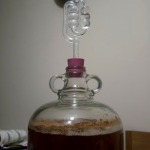 If you’re using an airlock, timing the bubbles as they escape is a great way of gauging how fast your cider is fermenting. The rate of fermentation will speed up as the yeast population multiplies, and then will start to fall again as the sugars in the mix get used up. At peak activity, you can expect a bubble every two seconds or possibly even slightly faster. For me this usually happens about a week after fermentation starts, though it depends on temperature, the sugar content of your apple juice, and how viable your yeast was in the first place. You will notice a layer of yeast forming on the bottom of the demijohn, too, which is quite normal.
If you’re using an airlock, timing the bubbles as they escape is a great way of gauging how fast your cider is fermenting. The rate of fermentation will speed up as the yeast population multiplies, and then will start to fall again as the sugars in the mix get used up. At peak activity, you can expect a bubble every two seconds or possibly even slightly faster. For me this usually happens about a week after fermentation starts, though it depends on temperature, the sugar content of your apple juice, and how viable your yeast was in the first place. You will notice a layer of yeast forming on the bottom of the demijohn, too, which is quite normal.
If you’re not using an airlock then you’ll have to rely more on appearances to judge when peak fermentation has passed. As things start to slow down a little, you’ll notice the frothy crud on the surface reducing and being replaced by a layer of much ‘cleaner’ looking bubbles, and the contents of the demijohn will appear to be ‘fizzing’.
 Once this has happened (and the rate of bubbles through your airlock has reduced to one every four or five seconds) carefully remove the stopper, without contaminating it, and top up with the rest of your apple juice, to half an inch or so below where the shoulder of the demijohn meets the neck, before re-stoppering. You’re adding a nice dollop of extra sugar, so expect the fermentation to speed up again for a bit, but hopefully it shouldn’t foam the way it did to start with.
Once this has happened (and the rate of bubbles through your airlock has reduced to one every four or five seconds) carefully remove the stopper, without contaminating it, and top up with the rest of your apple juice, to half an inch or so below where the shoulder of the demijohn meets the neck, before re-stoppering. You’re adding a nice dollop of extra sugar, so expect the fermentation to speed up again for a bit, but hopefully it shouldn’t foam the way it did to start with.
Apart from providing a useful gauge of fermentation rate, the airlock serves another important purpose – it allows the waste gas from fermentation out, so that the demijohn doesn’t pressurise (which would be extremely hazardous!), but prevents exchange with the oxygen in the atmosphere. This keeps the cider bathed in carbon dioxide, which prevents oxidation of your cider – oxidation leads to spoilage, and even allows the accidental creation of cider vinegar if appropriate microorganisms are present.
Why, then, have I suggested you could go ahead without one? Carbon dioxide, conveniently, is heavier than air, so while the cider is actively fermenting, it will form a protective blanket over the cider and should prevent oxidation. The key detail here is ‘actively fermenting’. With an airlock fitted, there’s no rush to do anything once fermentation finishes, as the blanket of carbon dioxide is retained in the demijohn. This gives the option of a longer period ‘resting’ in the demijohn, either for convenience or maturation, once fermentation is finished. The cotton wool plug will keep bugs out (at least it will if it’s fitted properly!), but won’t stop the progressive exchange of gasses from the atmosphere once there’s no active CO2 production forcing the air out, so accurate identification of the end of fermentation and rapid bottling at this stage is particularly important.
 Now you just need to wait for it to finish fermenting. The rate of bubbles (and fizzing in the cider) should slow down progressively, and eventually stop. When it does, there should be no visible bubbles rising in the demijohn, no layer of bubbles on the surface, and no activity in the airlock. The cider will start to ‘drop clear’, that’s to say the yeast in suspension will settle to the bottom and the liquid will be clear again – and look surprisingly like it did in the very beginning. From topping up to dropping clear, in a 4.5 to 5 litre volume, tends to take about a fortnight to three weeks. Be patient here and don’t rush it, but also don’t leave things too long if you’re using a cotton wool plug (if you’re ‘under lock’, you can ignore it for as long as you like – I’ve left cider at this stage for several months before bottling with no ill-effect). If the end of fermentation coincides with a particularly chilly day, maybe give it a day or two to see if it re-starts when things warm up a little again.
Now you just need to wait for it to finish fermenting. The rate of bubbles (and fizzing in the cider) should slow down progressively, and eventually stop. When it does, there should be no visible bubbles rising in the demijohn, no layer of bubbles on the surface, and no activity in the airlock. The cider will start to ‘drop clear’, that’s to say the yeast in suspension will settle to the bottom and the liquid will be clear again – and look surprisingly like it did in the very beginning. From topping up to dropping clear, in a 4.5 to 5 litre volume, tends to take about a fortnight to three weeks. Be patient here and don’t rush it, but also don’t leave things too long if you’re using a cotton wool plug (if you’re ‘under lock’, you can ignore it for as long as you like – I’ve left cider at this stage for several months before bottling with no ill-effect). If the end of fermentation coincides with a particularly chilly day, maybe give it a day or two to see if it re-starts when things warm up a little again.
The only cast-iron way of knowing whether your cider has finished fermenting fully (or is ‘fermented out’ in the jargon of brewing, that’s to say, fermented until there are no fermentable sugars left) is with a hydrometer. In any case hydrometers are really cool-looking, delicate pieces of laboratory glassware and it’s almost worth buying one just because they’re so neat! Rarely, fermentation can stop before this point, a situation known as a ‘stuck fermentation’ leaving sugars behind that could let fermentation re-start in an unpredictable way in the bottle. The risk here is that you could accidentally create ‘bottle bombs’ which pressurise excessively during storage and risk exploding (please don’t dismiss the potential hazard of flying shards of glass shrapnel!). For this same reason, do not under any circumstances be tempted to bottle early in an attempt to achieve a sweeter cider – the only safe approach is to ferment out to get a completely dry cider, and then correct this ‘issue’ (if, that is, a bone-dry cider isn’t to your taste!) later on in the process.
Your finishing gravity, if using a hydrometer, should be near enough 1.000, and be stable for at least 24 hours. It goes without saying that the hydrometer and jar, like everything you allow into contact with your cider, must be carefully sterilised and rinsed before every use! For extra brewing-geek credit, if you also take the starting gravity of the apple juice before you start fermenting it, you can work out the alcohol content of your final brew. There are calculators on various websites to help you with the maths! To be quite honest, I tend not to bother with the hydrometer when I’m making this cider – so it’s a bit of ‘do as I say and not as I do’!
When you’re confident your cider has fermented out fully, and it’s dropped clear in the demijohn, it’s time to bottle.
Stage 2 – Bottling
Sterilise all your bottles and caps following the directions with your steriliser, and rinse very carefully. Also sterilise and rinse your syphon tube and any associated nick-nacks (racking cane, tap / bottling stick etc). Place your demijohn on the table or kitchen work top, and your bottles on the floor below them.
Into each of the bottles, you want to have added a small amount of sugar, this is to allow secondary fermentation in the bottle – but just a small controlled amount. This process is known as ‘priming’. This will produce a little carbon dioxide – in a pressurised container this time – and make your cider sparkling, which is how most people like it! You can also add some non-fermentable sweetener if you want your cider slightly sweeter. I favour ‘Splenda’, which seems to lack the bitter back-taste you get with some artificial sweeteners. If you’re going to use something else check carefully that it really *is* non-ferementable.
I add one teaspoon of sugar per litre of cider (half a teaspoon in a pint bottle, about 3/4rs of a teaspoon in a 750ml). These should be safe quantities and shouldn’t create any bottle bombs, while providing a nice sparkle. Do not be tempted to exceed them! I enjoy quite a dry cider, so I add a matching amount of Splenda – you can adjust this to your taste, though, so experiment. Put the sugar and sweetener, if using, into your bottles before you start to syphon, since adding it afterwards tends to make everything fizz over (it’s somewhat reminiscent of the Mentos-in-cola trick, but a bit less dramatic!). If you’d rather avoid artificial sweeteners but don’t enjoy a dry cider, you can top up your cider with a splash of apple juice in the glass at serving time.
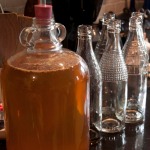 If you can secure the use of a glamorous assistant, they will come in very handy for bottling, since you can leave them in control of the top bit of the syphon tube. [How to syphon your home-brew.] If you have a racking cane, siphoning can be a one-handed job, as the ‘u-bend’ attachment should stop the yeast sediment being drawn into the syphon. Without one you’ll need some way of keeping the tube out of the bottom of the demijohn. In the absence of an assistant, you can rig something up with string and tie the syphon tube to the neck of the demijohn at an appropriate depth. A spare pair of hands is more reliable, though!
If you can secure the use of a glamorous assistant, they will come in very handy for bottling, since you can leave them in control of the top bit of the syphon tube. [How to syphon your home-brew.] If you have a racking cane, siphoning can be a one-handed job, as the ‘u-bend’ attachment should stop the yeast sediment being drawn into the syphon. Without one you’ll need some way of keeping the tube out of the bottom of the demijohn. In the absence of an assistant, you can rig something up with string and tie the syphon tube to the neck of the demijohn at an appropriate depth. A spare pair of hands is more reliable, though!
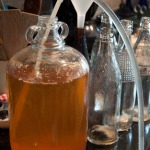 You may well be wondering why the faff with a syphon tube when you could just pour the cider into the bottles with a funnel. There are two reasons, really – the first is to reduce the amount of yeast sediment disturbed, which in turn will reduce the amount of sediment in your bottles, and in your finished drink. The second is our old friend oxidation – correctly performed, siphoning minimises the contact between the air and your precious cider.
You may well be wondering why the faff with a syphon tube when you could just pour the cider into the bottles with a funnel. There are two reasons, really – the first is to reduce the amount of yeast sediment disturbed, which in turn will reduce the amount of sediment in your bottles, and in your finished drink. The second is our old friend oxidation – correctly performed, siphoning minimises the contact between the air and your precious cider.
 So, carefully syphon your cider into your bottles, leaving about a 1″ space at the top. A ‘bottling stick’ or a tap in your syphon tube makes controlling the flow a lot easier. You want to fill the bottles with the end of your syphon tube right at the bottom of your bottle, so that it stays under the fluid level and minimises exposure of the cider to the air. There’s a bit of a knack to syphon-filling bottles, but you’ll get there eventually. Do put newspaper or something absorbent down on the floor if it’s not easy to clean! Try to avoid drawing yeast sediment or crud into your bottles from the demijohn as much as you can, but don’t worry too much about it, it’s not a disaster! Any extra cider that isn’t a full bottle’s worth? Drink it – it’s your first taste of your brew, and while it’s not ‘finished’ yet, it’s definitely cider, in a flat, old-fashionned-scrumpy kind of way!
So, carefully syphon your cider into your bottles, leaving about a 1″ space at the top. A ‘bottling stick’ or a tap in your syphon tube makes controlling the flow a lot easier. You want to fill the bottles with the end of your syphon tube right at the bottom of your bottle, so that it stays under the fluid level and minimises exposure of the cider to the air. There’s a bit of a knack to syphon-filling bottles, but you’ll get there eventually. Do put newspaper or something absorbent down on the floor if it’s not easy to clean! Try to avoid drawing yeast sediment or crud into your bottles from the demijohn as much as you can, but don’t worry too much about it, it’s not a disaster! Any extra cider that isn’t a full bottle’s worth? Drink it – it’s your first taste of your brew, and while it’s not ‘finished’ yet, it’s definitely cider, in a flat, old-fashionned-scrumpy kind of way!
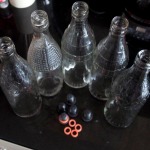 About my bottles, incidentally – they’re old lucozade-type inner-threaded fizzy drink bottles with rubber-gasket stoppers, which I was given by a lovely chap on Freecycle. They’re more or less the perfect home-brew bottles as they’ll take some pressure but don’t require capping equipment, and aren’t gas-porous like plastic, so if you’re offered any, snap them up, even if they need a bit of TLC, new stoppers and gaskets remain available from home-brew suppliers. Obviously, discard any chipped or cracked bottles, since these are at high risk of explosion!
About my bottles, incidentally – they’re old lucozade-type inner-threaded fizzy drink bottles with rubber-gasket stoppers, which I was given by a lovely chap on Freecycle. They’re more or less the perfect home-brew bottles as they’ll take some pressure but don’t require capping equipment, and aren’t gas-porous like plastic, so if you’re offered any, snap them up, even if they need a bit of TLC, new stoppers and gaskets remain available from home-brew suppliers. Obviously, discard any chipped or cracked bottles, since these are at high risk of explosion!
Stage 3 – Secondary fermentation
 Now seal your bottles tightly, up-end them a few times to dissolve the sugars, and then stash them somewhere, upright, for a couple of weeks for the secondary fermentation to complete. If they’re clear bottles, you can monitor this – the contents will go slightly cloudy, before clearing again, ‘throwing’ a thin layer of yeast on the bottom of the bottle. Once they’re clear, they’re ready to drink (though they will keep for at least a year – I bet you won’t wait that long though!).
Now seal your bottles tightly, up-end them a few times to dissolve the sugars, and then stash them somewhere, upright, for a couple of weeks for the secondary fermentation to complete. If they’re clear bottles, you can monitor this – the contents will go slightly cloudy, before clearing again, ‘throwing’ a thin layer of yeast on the bottom of the bottle. Once they’re clear, they’re ready to drink (though they will keep for at least a year – I bet you won’t wait that long though!).
Stage 4 – Drinking!
Chill in the fridge door (keeping the bottle upright will minimise disturbance of the yeast sediment) and then open on a suitable occasion to share with good friends – let’s face it, they’ll *have* to be good friends to be willing to be guinea-pigs for sampling your first home-brew experiment! The bottle should open with a gentle ‘pssssst!’. Pour your cider gently, but all in one go, leaving as much of the sediment behind as you can. Don’t worry if you get some yeast in the glass, though, it looks quite traditional and won’t spoil the flavour – and contains lots of lovely B vitamins!
Sit back and enjoy – your care and patience has hopefully been richly rewarded with a perfect crisp cold glass of home-brewed cider. Get going now, and you’ll be all set when summer finally arrives!
Read more from the Country Skills blog >>

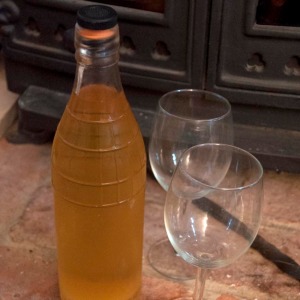


Your hydrometer link 404s; it’s missing a trailing “l”, I think.
Thank you, you’re quite right, corrected that now 🙂 K
Pingback: Last of the Harvest – elderflower ‘champagne’ | Country Skills for Modern Life
i really enjoyed reading this as it settled me a little because its my first time and was worried about how cloudy my bottle was looking, thanks also for telling me about the spoon of sugar to help fizz my cider up in each bottle, i also had old wine bottles but i must go find some swing top tyoe grolsch bottles, thanks!! paul from ireland
Thank you for your comment – and for wading your way through what I admit is a real epic monster of a blog post!
Good luck with your first cider-making efforts, and please come back to let us know how it went (and what you think of the end product!)?
Pingback: The Eurovision Drinking Game – because in the country, you make your own fun! | Country Skills for Modern Life
This is a great blog…I have pretty much followed it to the word, apart from the fact that I have pressed my own apples…I must admit, the initial fermentation in the demijohn took literally 4 days, and I topped up with shop bought apple juice to add a little complexity.
I still have dozens of kg’s of apples coming, so I am looking forward to experimenting a little more and using this handy little guide as my base!
Thanks for taking the time to put it all down in pixels.
You’re welcome Aaron – so glad it was of use to you (thank you for wading through all of it!) and please do come back and let us know how your cider turned out!
Hello Kate,
Thanks for the very informative post. I am planning on starting my first ever batch of cider next week and while planning I have run into an issue which is the danger of oxidation. I’d really like your opinion on the following:
I got myself 15L of pasteurised juice from a local orchard. My kit consists of 2 25L fermentation buckets (both fitted with an airlock), racking cane, hydrometer, yeast nutrients etc but no glassware.
My first plan was to ferment the 15L in one bucket, let it sit for a month (or SG=1.000) and then rack it off into the second bucket to clear, then bottle it with some priming sugar. I did some research which leads me to believe that the second stage as described will probably spoil the batch because of the surface area that will be in contact with the air (no protective CO₂ blanket) leading to oxidation.
My revised plan is to ferment the 15L, leave it in the bucket on the lees for 6 to 8 weeks to clear and then just carefully bottle it.
Is oxidation really that much of a problem? Are there any ways other than adding chemicals to prevent oxidation? Are there any problems with bottling right after the primary stage?
Thanks!
Hi Richard,
Thank you for stopping by and glad you found the post helpful in your cider-making plans. I’ve started freshly pressed apple juice in a bucket before, but then racked to demi-johns under lock very quickly (within a week or two, while fermentation was still ongoing). As long as you do this quickly and then preserve the lock, it will keep stable in the secondary vessel for over a year, but yes, you’re right to be worried about oxygen getting in.
If I’m using filtered apple juice so that the sediment is just yeast rather than also containing apple solids, then I just start directly into demijohns, allow to ferment out under lock, and then bottle directly from the primary fermenter (carefully, using a racking cane). Adding a bit of sugar at bottling time to allow a small in-bottle secondary fermentation both adds sparkle to the cider and protects it to a degree against oxidation from air exposure during bottling.
Hope this makes sense and helps you out a little – I’d love to hear how you get on in due course!
This is excellent i have recently made a few batches using this method and created some extremely nice cider thats is very merry indeed it is nice and strong slightly dry just how i like it thankyou for explanation and so detailed when written good job 😉
it is nice and strong slightly dry just how i like it thankyou for explanation and so detailed when written good job 😉
Thank you for your kind comments scotty! Glad the post & technique have been of use to you! Kind regards, Kate.
Really helpful thank you! Really help clear up some confusion I’ve had as I’ve only just started brewing. I was wondering if you knew whether or not putting berries/other fruit in the demijohn during fermentation would help flavour the cider?
I have to admit I’ve never tried this (I’m not a fan of flavoured ciders!). I can’t see many reasons not to try – though I have no idea how well it would work – the only concern would be to avoid introducing potentially unhelpful ‘hitchhikers’ on the fruit – I would be tempted to scald anything I was going to use with boiling water after washing it carefully – it might even be worth considering a bath in some campden first? Or just chance it I guess – we make no effort to sterilise the apples in freshly pressed cider, after all!
hi im new to homebrewing and bought a wine and cider kit but wanted to make my own from scratch. with the kits ive got ive used sugar in them in the first instance, where your recipe only has sugar in at the end of fermentation in the bottles, but i was under the impression the sugar is what helps create the alcohol content!! im reading different things from different sites and now am a little confused over the sugar. please could you explain what the sugar is for and why you dont use it during the initial fermentation. thanks steph
Hi, Steph! I’ll see what I can do!
Yes – the sugar in the mix is what the yeasts ferment into alcohol. BUT – apple juice contains sugars, that’s why it tastes sweet! If you look at the nutritional information on the carton, you’ll be able to work out about how much is in there. By my rough calculations, for the juices I’ve used, have suggested a final alcohol %age of around 4%, which I’m happy with.
The natural sugars in the juice are all fermented out in the demijohn, which is why I add an extra little bit at bottling time – if I didn’t, the cider would only be very lightly sparkling, as fermentation also gives out CO2. In a sealed container, that goes into solution in the liquid, but under airlock in a demijohn it can escape, so it doesn’t cause fizz. This priming sugar adds less than 0.5% additional alcohol and don’t add too much or you’ll over-pressurise your bottles and they might explode!
I have seen real juice recipes that add extra sugar to increase the finished alcohol %age of the cider. I don’t like to do this for two reasons – firstly, and most importantly, I consider ~4% is perfect for sipping on a hot summer’s afternoon. This is of course a matter of personal judgement and you might disagree with me! The second reason is that any sugar you add will be fermented to alcohol. The trouble is that this actually dilutes the apple flavour in the final cider, since you end up with less apple juice in each mouthful (because some is now the extra volume from the sugar). Also, you’ll get completely wrecked on it and probably embarrass yourself, and have a filthy hangover the next day. The choice, as they say, is yours!
Hope this answers your questions – do let me know if not and I’ll have another try!
Thanks for stopping by the blog, and good luck with your home-brew cider endeavours. It’s worth the trouble, I promise!
Hi, I really enjoyed reading your blog post and it’s inspired to me to give Cider making a go!
I was wondering what changes you’d suggest to this recipe if using REAL apple juice (not from a carton – from an apple). Would sugar need to be added to the recipe? If yes, then how much? Also, would there be a specific variety of apple you’d recommend to use?
I live nearby a farm which have a ‘pick your own’ apple orchard and I have a great Tefal juicer sp I’d really like to do it this way. I can get roughly 1ltr of juice from 2.5kg of apples, so I’d need 10kg to get the 4ltrs required.
Thanks a lot.
Yes, absolutely use real apples. I wouldn’t add any extra sugar – remember that once the cider is fermented out all do that sugar will be alcohol, so effectively you’re watering down the flavour of the drink while making it more potent. Choose an apple with a flavour you love, or better still, a mix of apples. And don’t worry if the juice you’ve made turns brown, that will reverse during the brewing process. I have a couple of blog posts on here about traditional cider making from apples – you should find them if you type ‘cider’ into the search box at the top of the blog.
Good luck!
Hi, thanks for the reply. I’ve just started off the process, took me about 3hrs to juice all the apples! The liquid is very cloudy but it has been filtered three times with a sieve and muslin cloth. Also, rather than adding the tea I used Wine Tannin which I think will do the same job (hope this won’t spoil it?).
A couple of stupid questions: do I leave the cap on or off the air lock?
It states that we should ferment until it stops, but roughly how long usually does it does this usually take?
Thanks a lot!
Tannin should be fine – it’s a specialist ingredient which I was trying to avoid with my blog directions, but will probably be better than the tea, as long as you haven’t over-done it!
The cloudiness may clear when the yeast drops out, then again it may not. I’ve had real cider batches go both ways, I don’t know why some do or some don’t. It won’t affect the flavour, and cloudy ‘scrumpy’ cider is very traditional!
Use the airlock cap. It doesn’t form a seal and should hopefully stop insects getting in and drowning themselves in it. It’s very difficult to say how long fermentation will take – processed apple juice is usually faster than fresh-pressed, and then it will depend on how much sugar is present in your juice, the characteristics of your yeast, temperature and so on… As a rule of thumb somewhere between one and three weeks, but trust the airlock!
Good luck!
Hi,
Brilliant article and really helpful as I’m just getting into home brewing. I’ve been reading numerous posts and forums all over the place to pick up hints, tips and recipes and I’m sure I read a post somewhere that stated if you allow the ‘must’ to drop completely clear then effectively all the active yeast has died and settled to the bottom and therefore you won’t be able to perform secondary fermentation in the bottle as there’s nothing left to eat the ‘priming’ sugar (as it were)…
However I like the idea of clearing as much as possible before bottling to reduce the amount of sediment in the bottle as I’m not sure I can go through the whole ‘clearing in inverted bottles, freezing the neck and disgorging’ faff 🙂
Appreciate your thoughts,
Jay
I think this may well be true if you’ve left your lees settled for weeks and months, however I’ve never had any kind of problem with failed bottle conditioning, and I think there are two main reasons for that.
First, the time – it’s only a matter of weeks, not months or years. Yeasts are resilient buggers, and can go dormant for some time (particularly if the alcohol concentration is below the kinds of levels that will kill them, which should be the case here) – otherwise dried yeast wouldn’t work.
Secondly, while it might look clear, there will still be some yeast in suspension, and however careful you are, you’re going to stir some up while you’re syphoning.
And because there’s some live yeast in the bottles, you should get good conditioning and nice sparkling cider, but there will be a little yeast deposit on the bottom of the bottle. Not the end of the world and if you pour carefully you should barely disturb it.
Thank you for stopping by the blog, and good luck!
Was really pleased to find this site…I’m a Brit living in Singapore and wanted to give brewing cider a go. I followed your directions to brew from supermarket apple juice. I set up 2 5L demijohns with airlocks and used a liquid cider yeast from a local beer shop.
After starting to bubble, I was seeing a very small head appear, barely as much as 1/2 cm. I could see minute bubbles fizzing to the surface, but saw no lumps of yeast sediment forming and now after 2 weeks, the whole thing seems to be flat, clear, with no head or visible fermentation taking place.
Do you think this batch is a write off, or maybe it could be revived with some new yeast?
Being in a hot climate, I wonder if maybe it is too hot for the yeast and I need to try and keep the demijohns a little cooler?
Any advise to can offer to a novice would be greatly appreciated !
Angus
First and most important advice is this – Don’t give up on this batch! Prime & bottle it, wait a few weeks and see how it goes, it might be fine!
From what you’re describing it sounds like some fermentation did occur, temperature may be an issue, but it’s also worth checking that your apple juice really is pure (just pasteurised) rather than containing any preservatives as these can really interfere with fermentation – it’s their job I guess!
Good luck and let me know how things go in due course!
Thanks for stopping by the blog,
Kate
Many thanks for the advice Kate – much appreciated. All the apple juice used stated “no preservatives”, so hopefully that’s not the problem.
I’ve since seen advise on keeping the demijohns cool out here so will put that into practice next time.
I’ll continue with priming and bottling as suggested and will let you know the results for sure.
Please to say your advise was spot on – the end product was really good. Next batch already started but will try lower temperature a bit this time by keeping the demijohn wrapped in a wet towel
Good man for the updates! This is all very inspiring. What a lovely bunch of folk that have congregated. Awesome!
How have your next batches been? Got any further tips of tricks to add?
Hope you’re well, dude!
Hans
Hi Kate….quick update…..when I topped up the demijohns it all kicked off again and has been fizzing away happily again.
Needless to say I’m over the moon and can’t wait for bottling. Will let you know the final results.
Howdy, thanks for this post. I am trying my hand at my first batch. I used apples off my tree and juiced about 30L, which I have in a Speidel Plastic Fermenter. The stopper has stopped bubbling and the weight measurement is around 1.000/.999 so I think it is ready to bottle, however it has a lot of debris floating in it, which I am assuming is yeast. There is definitely sediment on the bottom, but this is little bits floating freely in the whole jug. I used Champagne yeast after killing the wild yeast with tablets.
Should I let it rest for a few more weeks?
Hi, it does sound like your juice has fermented out. I’m not familiar with that brand of fermenter but assuming your cider is under airlock, you can leave it for as long as you like (within reason!). A week or so in a cool place should allow a lot of that suspended material to drop out giving you a nice clean cider – and any left behind will probably drop down into the bottle sediment with the secondary fermentation debris, anyway. Good luck and enjoy your cider!
Thanks! Yes it is under an airlock. I’ll leave it sit for a week more or so. I guess the trick is patience. 😉
Good evening Kate and thankyou for this blog. I am a newby to home brewing and love cider. I like the simplicity of the process and the small amount of equipment required. I have two little boys and no space so this is perfect. Ive currently got two demijohns of mead on the go and was looking for other demijohn recipes to have going on rotation. The mead is a 3 week mead and is 1/2 way through. Ive bought what i need so will get this on the go tonight or tomorrow. I am presuming by leaving out the sugar, the results will be a flat scrumpy. I will let you know how i go on. I also have found a apple brandy liqueur recipe that i will have a go of. Right, better go. The little tiddlers are recking the place around me. Byeeee
Hi Mark and thanks for stopping by! You’re quite right – if you leave out the priming sugar you won’t get the sparkle in the bottle, though it may not be completely flat if you don’t de-gas the cider before bottling (wine-making blogs will no doubt show you how) as there’s likely to be a bit of dissolved CO2 left over from the initial fermentation giving a little tingle of sparkle on the tongue!
Good luck with your cider making and do pop back and let us know how it went!
Hello again, well finally, my 3 week mead stopped fermenting (More like 6 weeks lol) which gave me back 2x demijohns to try your scrumpy. I have got one on the go following your instructions although I haven’t added the yeast nutrient. I had none and my local shop with home brew equipment etc had none either. I was too eager to order on-line and wait for it. Will it be OK? I was going to try one demijohn with the nutrient and one without, to see what the differences are. Just wondering how long on average it takes to fully ferment. I can then get my second one on the go 1/2 way through the first. I want to keep a rolling brewing system going. One more question. On researching the 3 week mead recipe, apparently it uses the same amount of yeast in its 2 litre batches as it would in say a 4 litre batch which speeds the whole thing up. I was wondering if this could be the same for the scrumpy. Have you ever tried using more yeast to see if it ferments quicker and tastes the same etc. Or at least brew a 2 litre batch with 1 teaspoon of yeast. Any advice would be brilliant
Again, thank you in advance for any info and again for the blog 🙂
Bye for now, take care
Mark
Can I use carbonation drops instead of adding sugar to prime?
I think these are just sugar, so yes, go right ahead!
Hi Kate
Thanks for this I’ve just made my first batch so looking forward to seeing how it turns out.
I’ve made 2 demijohns of cider, so fingers crossed.
Was going to ask if you have ever added other things to this to boost the flavour, like frozen fruits, or cinnamon sticks? I”m considering this when it’s time to top up the demijohns?
Let me know your thoughts.
Thanks again
Matt
Hi Matt! Good luck with your ciders. You can mix it up and add flavours in all sorts of ways but I would suggest that you keep at least one of your demijohns ‘natural’ first time, if only to get a sense of what the simple cider tastes like to help you make adjustments better in the future. Be careful with cinnamon though, it can be very over-powering as anyone who’s made a bad batch of mulled wine or cider will tell you!
Very helpful and written so smoothly.
Mine seems to be on track and I’ve gained some future gems. Thankyou very much.
Hello Kate
I set a batch of Cider going following your recipe but adding 200g of sugar to the 4 litres of shop bought pasteurised apple juice. As I was to be leaving my demijon in the garage I purchased a immersion heating unit from a brew shop on line, which I set to 20 degrees. The initial fermentation took approximately two days, give or take a few hours, at quite a vigorous pace (two bubbles a second at its peak). Then I topped up the demijon with ½ a litre of the same juice as fermentation seemed to have stopped, this started off the fermentation process again, but at a much slower rate, after a day or so everything had stopped again. I took a hydrometer reading and the level had dropped to almost one. I have removed the heater and am letting the brew settle for a few weeks prior to bottling.
I am surprised the fermentation period has been so short, does this seem possible to you?
Hi Dave,
It sounds like your fermentation has completed (assuming your hydrometer is accurate, that is!), congratulations! Go ahead and bottle your cider.
I think the reasons it’s gone so fast are to do with both the added sugar (which will have given the yeast a real ‘kick’ to get going) and the sustained high temperature – I do my brewing in my kitchen, which is rarely above 18 degrees and falls well below this at night, certainly down to between 13 and 14 and lower in cold weather. Because fermentation is a biological process those few degrees will make a real difference. Just a note of warning though – while 20 degrees should be fine, yeasts metabolise sugars differently at different temperatures, producing a different mix of fermentation products; fast, high temperature ferments can sometimes produce ‘off’ flavours in the finished brew, so tempting as it is to push the brew along with a bit of heat it may not always produce the very best results at the end of the day.
Congratulations on your first brew and please pop back and let us know what you think of it come tasting time.
Cheers!
Hi there. I’m just starting my first cider home brew using pressed juice from our own apples and this is by far the most helpful advice I’ve found anywhere in print or online – thank you! I’m now following your process but have a couple of rookie questions. 1. I’m using fermentation buckets with taps at the bottom. What are these for?! I assumed for racking off the good cider, but in your comments you talk about yeast forming at the bottom so this would suggest the taps won’t work for this. 2. Also, I have a large quantity of recycled wine and beer bottles. Would plastic or cork stoppers work or should I look at somehow using metal beer bottle tops if possible?
Thanks
Claire
Hello Kate, I have followed your recipe and I am now at the stage of adding extra juice for the final fermentation. My OG was 1046 which will give me something like 7.5% Alc which will be rather intoxicating :@). I have made 9 Litres in two dj’s with my wine-making immersion heaters inserted into them, they fermented really quickly.
Will keep you all updated !!!! Cheers!
hey i love how easy this sound and i cant wait to try it, thing is i have a 35 liter fermentation vessel so i just wonder cant this recipe be scaled up x7 to fill my vessel or what changes do i need to make to the recipe. I’m guessing 7 spoons of yeast is probably a lot Also do i need so much tannin. thanks
Thank you for this recipe, it gave me inspiration. I have since experimented with added flavors in secondary carboy. For example, ginger, hopped apricot, blackberry, oak chips, blueberries, elderflower, hopped, etc. http://www.homebrewtalk.com/showthread.php?t=544345
Hi
I’ve made this using a 5 litre demijohn and it was delicious:) so nice that I’m now going to try and make it in a 23 litre carbouy. I’m assuming that’s possible and I would just need to multiply everything? Any confirmations would be great before I start:) thanks for reading:)
This is awesome. I am concerned though that i am getting 2 bubbles a second after only 24 hours. Is this a problem? Temperature 20 deg C. Looks perfect but seems to be happening too quickly compares to your description.
Many thanks for any thoughts you may have on this.
Best regards,
Chris
Hi will a gallon sized demijohn be big enough?
Ideal, yes! Start with 4l so the froth doesn’t overflow, then top up later.
What sort of strength cider will this produce please?
Hi, the answer to this question depends entirely on how much sugar is in your apple juice, so there’s no way for me to give you an answer. You may be able to find out how much sugar is in your apple juice from the nutrition information, and there are online calculators to help you estimate sugar solution strength to alcohol by volume after fermentation. Hope this helps!
Hiya, stumbled across your great advice here! Fab, thank you for sharing. 🙂
Quick Question: Do we HAVE to bottle the cider – or can it remain stored in the demijohns for months on end rather than bottling – then just used from the demi-johns? (we would rack it maybe twice so there wasn’t too much sediment) – or would we lose our CO2 blanket???
You really need to bottle it or put it into a sealed keg (the homebrew kegs used for beer would be fine), if you’re going to leave it in the demijohn you need to be 100% confident it has fully fermented out and then stopper it tightly. The cider will be dry, and completely flat, but store safely. This will work fine but if you’re not fully fermented out and the temperature rises, demijohns are *really poor* pressure vessels and tend to explode. So user beware. You can’t leave it under lock indefinitely because gas exchange will occur slowly through the lock and the brew will start to oxidise.
Thank you so very much for taking the time to put this all into pixels (cheers for that one, Aaron Sullivan, below). This is something I have always wanted to do.
Fantastic read, written exactly as we think when doing things properly with not a jot left out, internal dialogue to boot! Top.
I’ll certainly swing you an email when I perfect my first batch and will certainly send you a bottle!
I hope you and you’re family are safe and well.
Love life, progress daily and live!
Hans
P.S: I’ll be using the long route for my makings. If a job’s worth doing, it’s worth doing properly. This entire blog is a treasure trove!